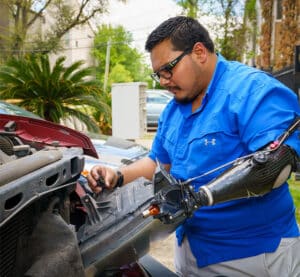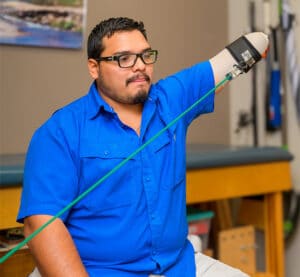An Upper Limb Amputee Prevails
By Sherri L. Edge
Photos by Arm Dynamics
 It can be hard to believe in the promise of tomorrow if you’ve lost part of your arm or hand in a traumatic accident. The physical and emotional toll from that type of injury is intense. Although prosthetic devices can help restore function, it’s not unusual for the residual limb to be so damaged that it limits a person’s ability to wear and use a prosthesis comfortably. That’s what happened to Ricardo Gasca after he lost his hand on the job in 2017. He was at the top of his game as a TIG welder and ironworker in the oil and gas industry. While building cryogenic storage tanks at work, he was involved in a freak accident that crushed his lower left arm. “It was pretty much severed below the elbow,” he said. “I had three back-to-back surgeries, and most of that was so I could keep my elbow. The only thing covering the end of my stump was skin grafts. My arm bones were just right there, sticking out, with no soft tissue for cushioning.” Three months later, Ricardo met with a team of upper limb specialists at Arm Dynamics, ready to talk about getting a prosthesis. “At first, I’d come in just to see the occupational therapist, do lots of stretching and work out with a Thera-Band. That helped me straighten out my left elbow.” He was fit with a prosthesis that featured a custom silicone socket with softer silicone at the bottom to cushion his bones. “I wore that arm almost every day for close to two years. When I didn’t have it on, the end of my stump was sensitive to the touch, and I was always bumping it against something. It hurt a lot.” Ricardo’s prosthetist and doctor agreed the only way to improve his arm for the long run was with revision surgery. Just the suggestion of another surgery can be overwhelming for people who’ve experienced a traumatic injury, and Ricardo was no exception. “I was very scared at first. I didn’t want any more surgery. There would be muscle and skin grafts too. Those take a long time to heal, and they increase the pain.”
It can be hard to believe in the promise of tomorrow if you’ve lost part of your arm or hand in a traumatic accident. The physical and emotional toll from that type of injury is intense. Although prosthetic devices can help restore function, it’s not unusual for the residual limb to be so damaged that it limits a person’s ability to wear and use a prosthesis comfortably. That’s what happened to Ricardo Gasca after he lost his hand on the job in 2017. He was at the top of his game as a TIG welder and ironworker in the oil and gas industry. While building cryogenic storage tanks at work, he was involved in a freak accident that crushed his lower left arm. “It was pretty much severed below the elbow,” he said. “I had three back-to-back surgeries, and most of that was so I could keep my elbow. The only thing covering the end of my stump was skin grafts. My arm bones were just right there, sticking out, with no soft tissue for cushioning.” Three months later, Ricardo met with a team of upper limb specialists at Arm Dynamics, ready to talk about getting a prosthesis. “At first, I’d come in just to see the occupational therapist, do lots of stretching and work out with a Thera-Band. That helped me straighten out my left elbow.” He was fit with a prosthesis that featured a custom silicone socket with softer silicone at the bottom to cushion his bones. “I wore that arm almost every day for close to two years. When I didn’t have it on, the end of my stump was sensitive to the touch, and I was always bumping it against something. It hurt a lot.” Ricardo’s prosthetist and doctor agreed the only way to improve his arm for the long run was with revision surgery. Just the suggestion of another surgery can be overwhelming for people who’ve experienced a traumatic injury, and Ricardo was no exception. “I was very scared at first. I didn’t want any more surgery. There would be muscle and skin grafts too. Those take a long time to heal, and they increase the pain.” 
 The revision would involve three surgeries that were several months apart. He would not be able to wear a prosthesis again until all the surgeries were completed. Ricardo felt he was going backward, as though he was starting all over again. “My mind was getting ahead of me, saying, ‘Everywhere I go, people will be staring at me again because I have one arm.’ I just want to fit in and not be noticed.” Could he come to believe the outcome would be worth it and a pain-free future was possible? He looked at his goals: get rid of the pain; make his arm look better; use a prosthesis comfortably; become a workplace safety supervisor; get married; be active and happy. “I could see that the revision surgery was my best chance to reach my goals. So I decided to toughen up, accept the situation and push through it.” The first surgery used part of Ricardo’s right quadriceps muscle to bulk up his residual limb and add plenty of soft tissues over the bones. Skin grafts were taken from his left leg to cover the open areas on his arm. The second and third surgeries reduced the bulk of his residual limb and focused on shaping his arm to make it aesthetically pleasing. “Even though most people won’t see my arm without a prosthesis, it was really important to me for it to look nice and rounded. I was extremely happy when it was all done.” Ricardo lost his arm on July 23, 2017, and in November 2023 he received his new, post-revision prostheses–a body-powered prosthesis with a V2P terminal device, an activity-specific prosthesis for playing pool and working out and a myoelectric prosthesis with a TASKA hand. It was the culmination of six years of effort, commitment and believing it was possible to create a better future. People with limb loss and limb difference understand what it means to face big challenges. For those considering limb revision surgery, Ricardo says, “If you have the right doctor and prosthetic care team, it’s going to be an improvement. I know that for sure now. I have no regrets whatsoever.”
The revision would involve three surgeries that were several months apart. He would not be able to wear a prosthesis again until all the surgeries were completed. Ricardo felt he was going backward, as though he was starting all over again. “My mind was getting ahead of me, saying, ‘Everywhere I go, people will be staring at me again because I have one arm.’ I just want to fit in and not be noticed.” Could he come to believe the outcome would be worth it and a pain-free future was possible? He looked at his goals: get rid of the pain; make his arm look better; use a prosthesis comfortably; become a workplace safety supervisor; get married; be active and happy. “I could see that the revision surgery was my best chance to reach my goals. So I decided to toughen up, accept the situation and push through it.” The first surgery used part of Ricardo’s right quadriceps muscle to bulk up his residual limb and add plenty of soft tissues over the bones. Skin grafts were taken from his left leg to cover the open areas on his arm. The second and third surgeries reduced the bulk of his residual limb and focused on shaping his arm to make it aesthetically pleasing. “Even though most people won’t see my arm without a prosthesis, it was really important to me for it to look nice and rounded. I was extremely happy when it was all done.” Ricardo lost his arm on July 23, 2017, and in November 2023 he received his new, post-revision prostheses–a body-powered prosthesis with a V2P terminal device, an activity-specific prosthesis for playing pool and working out and a myoelectric prosthesis with a TASKA hand. It was the culmination of six years of effort, commitment and believing it was possible to create a better future. People with limb loss and limb difference understand what it means to face big challenges. For those considering limb revision surgery, Ricardo says, “If you have the right doctor and prosthetic care team, it’s going to be an improvement. I know that for sure now. I have no regrets whatsoever.”

